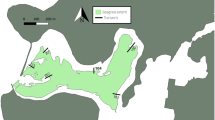Abstract
Denitrification by the sessile microbial community of the River Tamagawa was studied in laboratory experiments. Inorganic nitrogen loss was observed when river water was incubated with sessile microbial community of the river in a continuously circulating system. It was confirmed by the 15N tracer technique that both sessile microbial communities of unpolluted and polluted areas had denitrifying activity, even though they were incubated in oxygenated river water. The denitrification rate of the sessile microbial community taken from a polluted area, measured by the 15N tracer technique, was 8–16 mg N/m2/day in October and December, 1977, and it was enhanced 10-fold by raising the water temperature from 14 to 30° C. Denitrification in the river was also suggested by determining the N2: Ar ratio of gases evolved from the river bed.
Similar content being viewed by others
References
Aizaki, M. 1977. Development and metabolism of periphyton community in the middle region of the Tamagawa River. Dr. thesis, Tokyo Metropolitan University, Setagaya-ku, Tokyo.
Curtis, E. J. C., Durrant, K. & Harman, M. M. I. 1975. Nitrification in rivers in the Trent Basin. Water Res. 9: 255–268.
Eckenfelder, W. W. 1970. Water quality engineering for practicing engineers. Barnes & Noble, Inc., New York.
Edwards, R. W. & Rolley, H. L. J. 1965. Oxygen consumption of rivers muds. J. Ecol. 53: 1–19.
Hauck, R. D. & Bouldin, D. R. 1961. Distribution of isotopic nitrogen in nitrogen gas during denitrification. Nature. 191: 871–872.
Hauck, R. D., Melsted, S. W. & Yankwich, P. E. 1958. Use of N-isotope distribution in nitrogen gas in the study of denitrification. Soil Sci. 86: 287–291.
Kaushik, N. K. & Robinson, J. B. 1976. Preliminary observations on nitrogen transport during summer in a small spring-fed Ontario stream. Hydrobiol. 49: 59–63.
Kawai, A. 1972. Counting methods for numbers of bacteria taking parts in nitrogen cycle. (in Japanese) In: S. Mori et al. (eds.), A manual on methods for biological productivity of fresh waters. Kodansha. Tokyo: 291–295.
Kirkham, W. R. & Allfrey, V. G. 1972. Animal and plant cells and cell parts: Chemical composition. In: Biology data book. second ed. vol. 1. compiled and edited by Altman, P. L., and Dittmer, D. S. Federation on American Societies for Experimental Biology, Bethesda, Maryland: 387–392.
Kobayashi, J. & Morii, F. 1969. Chemical analysis of water (in Japanese) In: S. Mori et al. (eds.), A manual on methods for biological productivity of fresh waters. Kodansha, Tokyo: 476–480.
Koyama, T., Handa, N. & Sugimura, Y. 1972. Dissolved gases (in Japanese) In: A manual on methods for analysis of lake water and sea water. Kodansha, Tokyo: 14–31.
Owens, M., Garland, J. H. N., Hart, I. C. & Wood, G. 1972. Nutrient budgets in rivers. Symp. zool. Soc. Lond. no. 29: 21–40.
Painter, H. A. 1970. A review of literature on inorganic nitrogen metabolism in microorganisms. Water Res. 4: 393–450.
Rheinheimer, G. 1964. Beobachtungen über den Einfluß des strengen Winters 1962/63 auf das Bakterienleben eines Flusses. Kieler Meeresforsch. 20: 218–226.
Rheinheimer, G. 1965. Mikrobiologische Untersuchungen in der Elbe zwischen Schnackenburg und Cuxhaven. Arch. Hydrobiol. 29: Supple. Elbe-Aestuar 2: 181–251.
Sanders, W. M. III. 1966. Oxygen utilization by slime organisms in continuous culture. Air & Wat. Pollut. Int. J. 10: 253–276.
Solôrzano, L. 1969. Determination of ammonia in natural waters by the phenolhypochlorite method. Limnol. Oceanogr. 14: 799–801.
Tezuka, Y., Watanabe, Y., Hayashi, H., Fukunaga, S. & Aizaki, M. 1974. Changes in the standing crop of sessile microbes caused by organic pollution of the Tamagawa River. Jap. J. Ecol. 24: 43–49.
Author information
Authors and Affiliations
Rights and permissions
About this article
Cite this article
Nakajima, T. Denitrification by the sessile microbial community of a polluted river. Hydrobiologia 66, 57–64 (1979). https://doi.org/10.1007/BF00019140
Received:
Issue Date:
DOI: https://doi.org/10.1007/BF00019140




